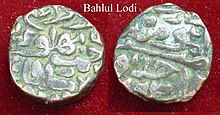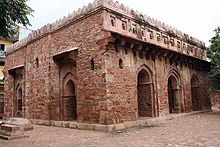Bahlul Lodi
Bahlul Lodi also Bhalol Khan Lodi ( Pashtun : بهلول لودي; † July 1489) was head of the Pashtun Lodi clan . In 1451 he became Sultan of Delhi .
Life
Bahlul's grandfather had already left his homeland and settled in Multan , whose governor Malik Mardan Daulat later became his father-in-law. He worked as a horse breeder and dealer and offered this to the sultans of the Sayyid dynasty of Delhi. During a campaign of conquest by the ruler of Malwa , he fought at the head of a troop allegedly 20,000 men on the side of his overlord Mohammed Shah IV , who awarded him the honorary title Khan-i-Khanan and also recognized his occupation of part of Punjab .
Domination
He attacked Delhi in 1443 and 1447, but only with the abdication of the last ruler of the Sayyid dynasty Aladin Alam Shah in 1451 was the way to take power. From then on he called himself Bahlul Shah Ghazi . In 1479 he subjugated the Sultanate of Jaunpur , ruled by the Sharqi dynasty ; in the following years he also incorporated Gwalior into his sphere of influence, but he had to deal with numerous local and regional rebellions. He died in 1489; his second eldest son Sikandar Lodi succeeded him.
mausoleum
The location of Bahlul Lodi's mausoleum remains unclear. The Archaeological Survey of India held a long time a mausoleum at Chirag, a southern suburb of Delhi , for Bahlul Lodi grave lay. Compared to other grave structures of the time, this is a rather simple and unadorned monument made of rubble stones without a rising dome but with a surrounding crenellated crown . The building was probably plastered from the start; In any case, plaster residues are still preserved. More recent research, however, identify the Shish Gumbad in the Lodi Gardens as Bahlul Lodi's mausoleum.
literature
- Hermann Kulke , Dietmar Rothermund : History of India. From the Indus culture to today. CH Beck, Munich 2010, ISBN 978-3-406-60414-0 .
Web links
- Lodi dynasty - Quick Facts (Engl.)
- Sultans of Delhi (1320-1526) (Eng.)
Individual evidence
- ↑ Simon Digby: The Tomb of Buhlul Lodi . In: The Bulletin of SOAS, Vol. 38, No. 3, 1975, pp. 550-561.
| personal data | |
|---|---|
| SURNAME | Lodi, Bahlul |
| BRIEF DESCRIPTION | Regent of the Islamic Sultanate of Delhi |
| DATE OF BIRTH | 14th century or 15th century |
| DATE OF DEATH | July 1489 |

